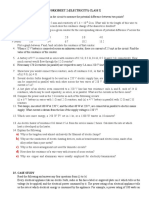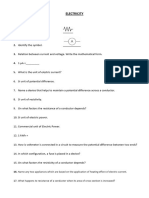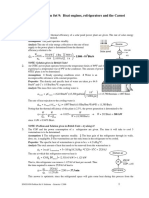ELECTRICITY 30 MARKS
ELECTRICITY 30 MARKS
Uploaded by
Sai Priya RVS BED 71Copyright:
Available Formats
ELECTRICITY 30 MARKS
ELECTRICITY 30 MARKS
Uploaded by
Sai Priya RVS BED 71Copyright
Available Formats
Share this document
Did you find this document useful?
Is this content inappropriate?
Copyright:
Available Formats
ELECTRICITY 30 MARKS
ELECTRICITY 30 MARKS
Uploaded by
Sai Priya RVS BED 71Copyright:
Available Formats
ELECTRICITY (30 MARKS)
1 MARK
1. Asser on (A): The voltmeter is always connected in parallel across the points where the
poten al difference is to be measured.
Reason (R): A voltmeter has a very high resistance, and connec ng it in parallel ensures
that it does not alter the current in the circuit.
a. Both A and R are true, and R is the correct explana on of A.
b. Both A and R are true, but R is not the correct explana on of A.
c. A is true, but R is false.
d. A is false, but R is true.
2. Assertion (A): A rheostat is a device used to regulate current in an electric circuit by
changing the resistance.
Reason (R): A variable resistance is used to regulate current without altering the voltage
of the source.
a. Both A and R are true, and R is the correct explanation of A.
b. Both A and R are true, but R is not the correct explanation of A.
c. A is true, but R is false.
3. A is false, but R is true. What is the SI unit of electric current?
a. Volt
b. Coulomb
c. Ampere
d. Ohm
4. Why are alloys preferred over pure metals for high-temperature applications?
a. They are cheaper than pure metals.
b. They are harder and more brittle.
c. They do not oxidize at high temperatures.
d. They have better electrical conductivity
5. Which of the following terms does not represent electrical power in a circuit?
(a) I2R
(b) IR2
(c) VI
(d) V2/R
6. The resistivity of insulators is of the order of
(a) 10-8 Ω-m
(b) 101 Ω-m
(c) 10-6 Ω-m
(d) 106 Ω-m
7. Electric power is inversely proportional _______.
2 MARKS
8. The potential difference between the terminals of an electric heater is 60 V when it
draws a current of 4 A from the source. What current will the heater draw if the
potential difference is increased to 120 V?
9. State the Joules law of heating.
10. Why is it not possible to connect devices like an electric bulb and an electric heater in
series in a circuit?
11. An electric bulb is rated 220 V and 100 W. When it is operated on 110 V. What will be
the power consumed?
3 MARKS
12. a) Define circuit and draw a closed-circuit diagram. (2m)
b) Define potential difference. (1m)
13. An electric iron consumer’s energy at a rate of 880 W when heating is at the maximum
rate and 360 W when the heating is at the minimum, the voltage is 220 V. What are the
current and the resistance in each case?
5 MARKS
14. a) A heater of 10 ohm, draws current of 10A from an electric source for 2 hours.
Calculate the heat produced in the heater. (2m)
b) An electric lamp, whose resistance is 20 Ω, and a conductor of 4 Ω resistance are
connected to a 6 V battery. Calculate (a) total resistance of the circuit, (b)current
through the circuit, (c) potential difference across the electric lamp and conductor. (3m)
CASE-STUDY
15. Substance through which charges cannot pass is called insulators. Glass, pure water, and
all gases are insulators. Insulators are also called dielectrics. In insulators, the electrons
are strongly bound to their atoms and cannot get themselves freed. Thus, free electrons
are absent in insulators. Insulators can easily be charged by friction. This is due to the
reason that when an electric charge is given to an insulator, it is unable to move freely
and remains localized. But this does not mean that conductors cannot be charged. A
metal rod can be charged by rubbing it with silk if it is held in a handle of glass or amber.
i) Calculate the current in a wire if a 1500 C charge is passed through it in 5 minutes.
ii) Electrons and conventional current flows in:
(a) same direction (b) opposite direction (c) any direction
iii) One-coulomb charge is equivalent to the charge contained in ___ electrons.
iv) What property of insulators allows them to retain an electric charge when rubbed
You might also like
- Grounding - Earthing - Grounding Grid Study GuideDocument11 pagesGrounding - Earthing - Grounding Grid Study GuideSridharan Priyadharsen100% (1)
- Electricity Set 1Document4 pagesElectricity Set 1lakshmiponganesanNo ratings yet
- DCC Class 10 Electricity AssignmentDocument4 pagesDCC Class 10 Electricity Assignmentkamalgujar74No ratings yet
- Class 8th ElectricityDocument5 pagesClass 8th Electricityjayverma1472007No ratings yet
- Worksheet X PhysicsDocument31 pagesWorksheet X PhysicsGuru PrasannaNo ratings yet
- Electricity NumericalDocument23 pagesElectricity Numericalnishkarm9898No ratings yet
- Achyuta Public School Electricity-Segment-1 Electric CurrentDocument6 pagesAchyuta Public School Electricity-Segment-1 Electric Currentavp sNo ratings yet
- works - CopyDocument3 pagesworks - Copyshreya.1q.09No ratings yet
- Assignment-class-10-electricityDocument5 pagesAssignment-class-10-electricityPurav ChopraNo ratings yet
- Aarambh Chapterwise Problems Aarambh Chapterwise ProblemsDocument20 pagesAarambh Chapterwise Problems Aarambh Chapterwise Problemsszeba0364No ratings yet
- current 1Document14 pagescurrent 1vaibhave BhatiaNo ratings yet
- X ScienceDocument7 pagesX ScienceSanghamitra ChakrabortyNo ratings yet
- DPP - Electricity (Prashant Kirad)Document12 pagesDPP - Electricity (Prashant Kirad)Abhinav Singh100% (4)
- QUESTIONBANKCLASSXCH1112docx 202411050904 0Document13 pagesQUESTIONBANKCLASSXCH1112docx 202411050904 0deepansh660No ratings yet
- X-Current Electricity Hot QuestionsDocument5 pagesX-Current Electricity Hot Questionstopg51253No ratings yet
- Worksheet Electricity Class X PhysicsDocument3 pagesWorksheet Electricity Class X Physicsvaibhav4gameNo ratings yet
- Class 10 Science Ch.12Document2 pagesClass 10 Science Ch.12Komal PatilNo ratings yet
- ElectricityDocument2 pagesElectricityyashasviupadhyay19No ratings yet
- Worksheet 2 Class X ElectricityDocument2 pagesWorksheet 2 Class X Electricityfarhaan akhtarNo ratings yet
- Current Electricity .Document8 pagesCurrent Electricity .majjicharanteja2006No ratings yet
- Electricity Q4Document7 pagesElectricity Q4D SiddaiahNo ratings yet
- 12 Current Electricity Assignment PDF.pdfdisplayName=12 Current Electricity Assignment PDFDocument4 pages12 Current Electricity Assignment PDF.pdfdisplayName=12 Current Electricity Assignment PDFsparshp703No ratings yet
- Electricity - Assignment - 1: PhysicsDocument5 pagesElectricity - Assignment - 1: PhysicsCRUEL HUNTERNo ratings yet
- Electricity Question BankDocument6 pagesElectricity Question BankBhuvanesh NagarajanNo ratings yet
- CBSE sample paperDocument10 pagesCBSE sample paperlijoush28No ratings yet
- CH-3 Sample - 1Document3 pagesCH-3 Sample - 1jayNo ratings yet
- Electricity WorksheetDocument11 pagesElectricity Worksheetsrijankanduri14No ratings yet
- Important Qstns 10 Board 2022-23Document11 pagesImportant Qstns 10 Board 2022-23ooooohozooorrrNo ratings yet
- Physics For X - CbseDocument9 pagesPhysics For X - Cbsearshad_bahNo ratings yet
- geno revision (1)Document2 pagesgeno revision (1)shajitheebaNo ratings yet
- Current Electricity Short QuestionDocument4 pagesCurrent Electricity Short QuestionakshanshrupaniNo ratings yet
- Question Bankof Physicsfor Class 10 THDocument16 pagesQuestion Bankof Physicsfor Class 10 THmeerneelofarh455No ratings yet
- Cbse 10 Electricity Question BankDocument16 pagesCbse 10 Electricity Question BankgpfphysicsNo ratings yet
- Answer Key x Class ElectricityDocument8 pagesAnswer Key x Class Electricityjaseenasho22No ratings yet
- Electricity ACPDocument7 pagesElectricity ACPmr.stranger2314No ratings yet
- Ans Electricity Additional Questions 1Document5 pagesAns Electricity Additional Questions 1Rohit JindalNo ratings yet
- Electricity Very ShortDocument2 pagesElectricity Very ShortmeharmelwaniNo ratings yet
- ch12 Class 10th Science AssignmentDocument2 pagesch12 Class 10th Science AssignmentPriyanka Kasturia100% (1)
- Class X ElectricityDocument1 pageClass X Electricitygupta.sanchita1808No ratings yet
- Class 10 Study MaterialDocument8 pagesClass 10 Study MaterialfactaboutasiaNo ratings yet
- Electricity QuestionsDocument11 pagesElectricity QuestionsYuresh YNo ratings yet
- Class 10 Physics .Electricity - Test PaperDocument1 pageClass 10 Physics .Electricity - Test Paperuma100% (1)
- Current Electricity Holiday AssignmentDocument9 pagesCurrent Electricity Holiday AssignmentmonchériNo ratings yet
- Final ws-1 Phy 10th ClassDocument5 pagesFinal ws-1 Phy 10th Classcharithsharma7No ratings yet
- Class-X Worksheet (Electricity)Document6 pagesClass-X Worksheet (Electricity)nandinichannel99No ratings yet
- Current Electricity: Level A QuestionsDocument6 pagesCurrent Electricity: Level A QuestionsTushar RajNo ratings yet
- Ohm's Law and Circuits: 2. Conductance, Insulators and ResistanceDocument29 pagesOhm's Law and Circuits: 2. Conductance, Insulators and ResistanceDita PramidaNo ratings yet
- W-PYQ-Chp-3-ElectricityDocument12 pagesW-PYQ-Chp-3-Electricityh63900124No ratings yet
- Rev XDocument2 pagesRev Xdaksh prajapatiNo ratings yet
- Class-10 Electrycity MCQDocument10 pagesClass-10 Electrycity MCQNuman KhanNo ratings yet
- Electricity Q2Document8 pagesElectricity Q2D SiddaiahNo ratings yet
- X Physics Segment 2 Q-BankDocument7 pagesX Physics Segment 2 Q-Bankavp s100% (1)
- ElectricityDocument12 pagesElectricitycutielavisha19No ratings yet
- Electricity DPP QuestionsDocument4 pagesElectricity DPP Questionsjam.gamesrNo ratings yet
- 10 Physics ch12 Electricity Ncert SolutioDocument19 pages10 Physics ch12 Electricity Ncert SolutiothemidnightismNo ratings yet
- Electricity 3qDocument3 pagesElectricity 3qsriramvatsansNo ratings yet
- Practice Assignment-Unit 1 - 220909 - 104145Document5 pagesPractice Assignment-Unit 1 - 220909 - 104145aps.apssingh9No ratings yet
- Class 12 Physics Chapter 2Document8 pagesClass 12 Physics Chapter 2Abhishek PandeyNo ratings yet
- Revision Test 1 (CH - Electricity)Document2 pagesRevision Test 1 (CH - Electricity)rduhan2006No ratings yet
- Electricity: Electric CurrentDocument10 pagesElectricity: Electric CurrentTajiriMollelNo ratings yet
- Complete Electronics Self-Teaching Guide with ProjectsFrom EverandComplete Electronics Self-Teaching Guide with ProjectsRating: 3 out of 5 stars3/5 (2)
- Electric Skateboard Motors (The Complete GuideDocument16 pagesElectric Skateboard Motors (The Complete GuideriverbendfcNo ratings yet
- REYQ-P8 (9) Y1B DatabookDocument131 pagesREYQ-P8 (9) Y1B Databookj.tisserand25No ratings yet
- Solutions ProblemSet9 Sem22007Document3 pagesSolutions ProblemSet9 Sem22007clearcastingNo ratings yet
- Hf61g00068b Jref R 0 Um GBDocument28 pagesHf61g00068b Jref R 0 Um GBchristopherNo ratings yet
- 2003 STAV Physics U2 - SolutionsDocument5 pages2003 STAV Physics U2 - SolutionsYue WeiNo ratings yet
- Generator Polarization Index (Pi) Test: 1 10/10/2014 Generators Automated Example Plant Example OwnerDocument17 pagesGenerator Polarization Index (Pi) Test: 1 10/10/2014 Generators Automated Example Plant Example OwnerJUAN CARLOS BERNAL MEJIANo ratings yet
- Xii STD - em NotesDocument166 pagesXii STD - em NotesHaard JoshiNo ratings yet
- 9.1 Lecture Material - Pneumatic Transport and Slurry TransportDocument51 pages9.1 Lecture Material - Pneumatic Transport and Slurry TransportDondon Irig100% (1)
- Physics Investigatory Project (Electronic Eye Security System)Document3 pagesPhysics Investigatory Project (Electronic Eye Security System)nabiha khanNo ratings yet
- Battery System at 220Kv Substation Punnapra: Anakha.MDocument20 pagesBattery System at 220Kv Substation Punnapra: Anakha.MManu JosephNo ratings yet
- 01 Sinusoidal WaveformsDocument66 pages01 Sinusoidal WaveformsSergio Garcia AlfaroNo ratings yet
- MG 5193Document7 pagesMG 5193PalmNo ratings yet
- General Relativity 2012 Harvey Reall Lecture NotesDocument172 pagesGeneral Relativity 2012 Harvey Reall Lecture NotesChung Chee YuenNo ratings yet
- Labnet Centrifuge Booklet - Feb 2015 - 11Document12 pagesLabnet Centrifuge Booklet - Feb 2015 - 11Shankar AcharNo ratings yet
- NEET UG Physics Rational Motion MCQsDocument40 pagesNEET UG Physics Rational Motion MCQssouravthakur17aNo ratings yet
- VRV-General-Catalogue-PCTVID2007 (Proyek Jawa 9&10 Coal Fired Steam Power Plant)Document19 pagesVRV-General-Catalogue-PCTVID2007 (Proyek Jawa 9&10 Coal Fired Steam Power Plant)antoni nugrohoNo ratings yet
- American OF Electrical: EngineersDocument48 pagesAmerican OF Electrical: Engineersaspirant AspiranturNo ratings yet
- Heat Transfer Through FinsDocument11 pagesHeat Transfer Through FinsKONDRU SIVAKUMARNo ratings yet
- Chemical and Statistical Thermodynamic ChemistryDocument230 pagesChemical and Statistical Thermodynamic ChemistryMohit KumarNo ratings yet
- Universal Gravitational Constant: EquipmentDocument13 pagesUniversal Gravitational Constant: EquipmentTraitor OneNo ratings yet
- Unit 4 Applied Chemistry CsitDocument9 pagesUnit 4 Applied Chemistry CsitBUDDHARAJU G GOPALA KRISHNAM RAJU 122062404010No ratings yet
- Vishay Sfernice: FeaturesDocument4 pagesVishay Sfernice: FeatureskoldanyelmasNo ratings yet
- (Ebooks PDF) Download Exploring Black Holes Introduction To General Relativity 2nd Edition Edwin F. Taylor Full ChaptersDocument62 pages(Ebooks PDF) Download Exploring Black Holes Introduction To General Relativity 2nd Edition Edwin F. Taylor Full Chaptersmonifadorkel100% (6)
- Unit 1Document57 pagesUnit 121ELB370MOHAMMAD AREEB HASAN KHANNo ratings yet
- Log TablesDocument5 pagesLog TablesMark ConnollyNo ratings yet
- Growatt Inverter Price List: S.No. Rating Model Price RemarksDocument1 pageGrowatt Inverter Price List: S.No. Rating Model Price RemarksViswanath MukherjeeNo ratings yet
- MTHN31E - Topic 6 - Applications of First-Order DEs - Cooling and Heating ProblemsDocument5 pagesMTHN31E - Topic 6 - Applications of First-Order DEs - Cooling and Heating ProblemsRenzel BaulaNo ratings yet
- Comparati DANFOSSDocument2 pagesComparati DANFOSSCesar VillarNo ratings yet
- Contraction, Velocity and Discharge Coefficients of A Rectangular Sharp Edeged SlotDocument49 pagesContraction, Velocity and Discharge Coefficients of A Rectangular Sharp Edeged SlotpapathsheilaNo ratings yet

























































































